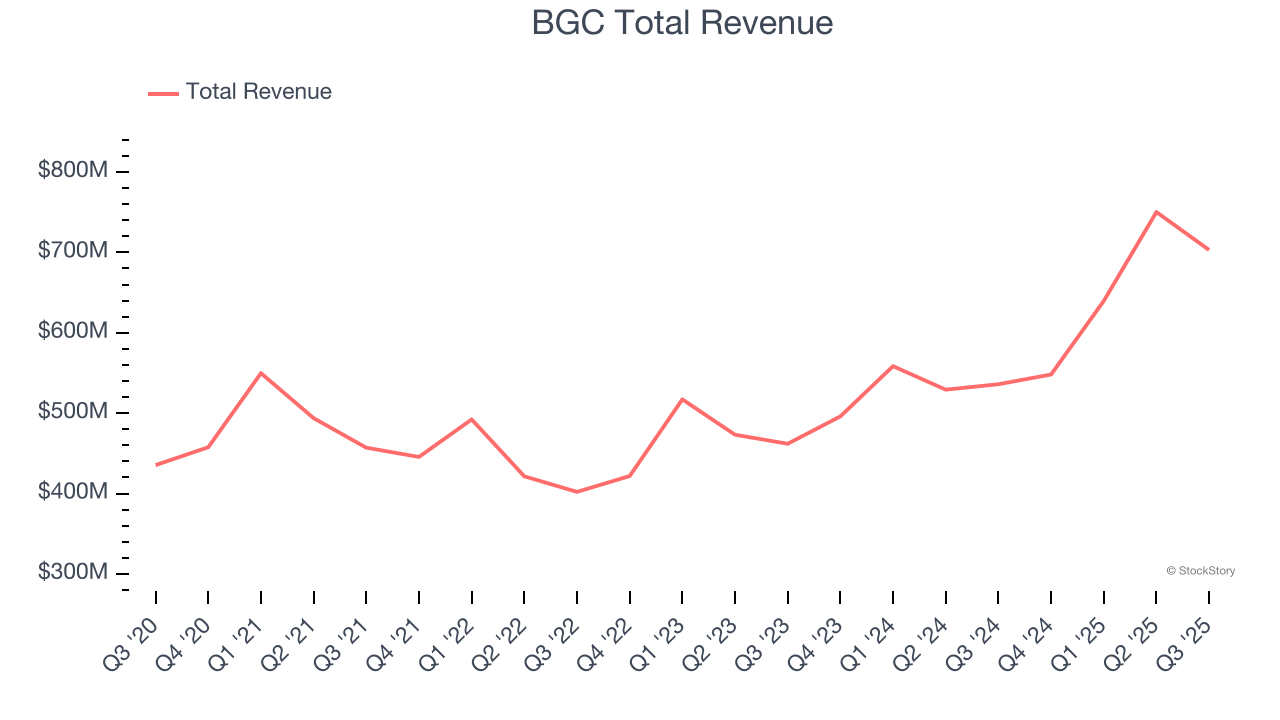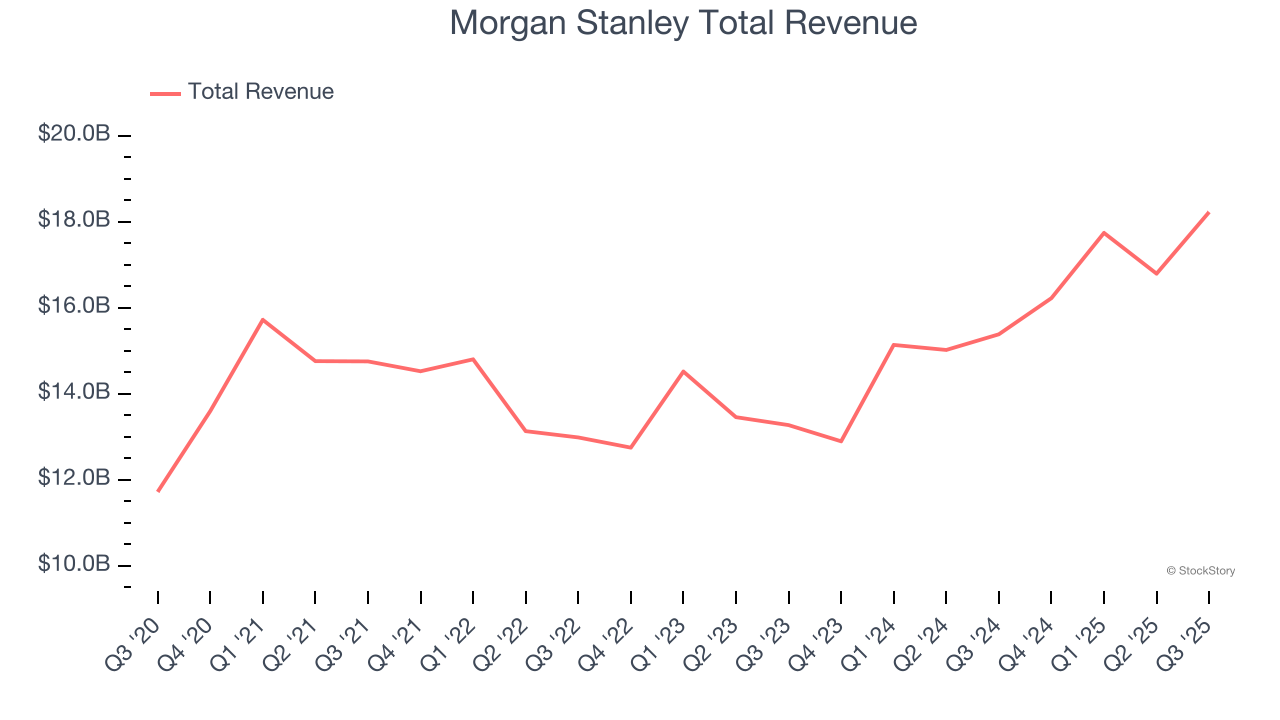|
|
|

|
|||||

|
|

The end of an earnings season can be a great time to discover new stocks and assess how companies are handling the current business environment. Let’s take a look at how BGC (NASDAQ:BGC) and the rest of the investment banking & brokerage stocks fared in Q3.
Investment banks and brokerages facilitate capital raises, mergers and acquisitions, and securities trading. The sector benefits from corporate activity during economic expansion, increased retail trading participation, and advisory opportunities in emerging sectors. Headwinds include economic cycle vulnerability affecting deal flow, compressed trading commissions due to electronic platforms, and regulatory capital requirements constraining certain higher-risk activities.
The 16 investment banking & brokerage stocks we track reported a very strong Q3. As a group, revenues beat analysts’ consensus estimates by 4.2% while next quarter’s revenue guidance was in line.
While some investment banking & brokerage stocks have fared somewhat better than others, they have collectively declined. On average, share prices are down 4% since the latest earnings results.
Tracing its roots back to 1945 and named after founder Bernard Gerald Cantor, BGC Group (NASDAQ:BGC) operates a global brokerage and financial technology platform that facilitates trading across fixed income, foreign exchange, equities, energy, and commodities markets.
BGC reported revenues of $703 million, up 31.2% year on year. This print fell short of analysts’ expectations by 4.5%. Overall, it was a slower quarter for the company with a significant miss of analysts’ EBITDA and revenue estimates.

Unsurprisingly, the stock is down 6.3% since reporting and currently trades at $8.55.
Is now the time to buy BGC? Access our full analysis of the earnings results here, it’s free for active Edge members.
Founded in 1924 during the post-WWI economic boom by former JP Morgan partners, Morgan Stanley (NYSE:MS) is a global financial services firm that provides investment banking, wealth management, and investment management services to corporations, governments, institutions, and individuals.
Morgan Stanley reported revenues of $18.22 billion, up 18.5% year on year, outperforming analysts’ expectations by 9.2%. The business had an incredible quarter with a beat of analysts’ EPS and revenue estimates.

The market seems content with the results as the stock is up 4.3% since reporting. It currently trades at $163.75.
Is now the time to buy Morgan Stanley? Access our full analysis of the earnings results here, it’s free for active Edge members.
Founded in 2006 by veteran investment bankers Joseph Perella and Peter Weinberg during a wave of boutique advisory firm launches, Perella Weinberg Partners (NASDAQ:PWP) is a global independent advisory firm that provides strategic and financial advice to corporations, financial sponsors, and government institutions.
Perella Weinberg reported revenues of $164.6 million, down 40.8% year on year, falling short of analysts’ expectations by 8.4%. It was a disappointing quarter as it posted a significant miss of analysts’ revenue and EPS estimates.
Perella Weinberg delivered the weakest performance against analyst estimates and slowest revenue growth in the group. As expected, the stock is down 8.1% since the results and currently trades at $17.32.
Read our full analysis of Perella Weinberg’s results here.
Founded in 1962 and headquartered in St. Petersburg, Florida, Raymond James Financial (NYSE:RJF) is a diversified financial services company that provides wealth management, investment banking, asset management, and banking services to individuals and institutions.
Raymond James reported revenues of $3.73 billion, up 7.7% year on year. This result surpassed analysts’ expectations by 2.7%. It was a very strong quarter as it also recorded a beat of analysts’ EPS estimates and a decent beat of analysts’ revenue estimates.
The stock is down 5% since reporting and currently trades at $157.74.
Read our full, actionable report on Raymond James here, it’s free for active Edge members.
Founded in 2007 by veteran banker Ken Moelis during the lead-up to the financial crisis, Moelis & Company (NYSE:MC) is an independent investment bank that provides strategic and financial advisory services to corporations, financial sponsors, governments, and sovereign wealth funds.
Moelis reported revenues of $376 million, up 33.9% year on year. This print missed analysts’ expectations by 3.2%. Aside from that, it was a mixed quarter as it also recorded a beat of analysts’ EPS estimates but a significant miss of analysts’ EBITDA estimates.
The stock is down 8.2% since reporting and currently trades at $61.34.
Read our full, actionable report on Moelis here, it’s free for active Edge members.
In response to the Fed’s rate hikes in 2022 and 2023, inflation has been gradually trending down from its post-pandemic peak, trending closer to the Fed’s 2% target. Despite higher borrowing costs, the economy has avoided flashing recessionary signals. This is the much-desired soft landing that many investors hoped for. The recent rate cuts (0.5% in September and 0.25% in November 2024) have bolstered the stock market, making 2024 a strong year for equities. Donald Trump’s presidential win in November sparked additional market gains, sending indices to record highs in the days following his victory. However, debates continue over possible tariffs and corporate tax adjustments, raising questions about economic stability in 2025.
Want to invest in winners with rock-solid fundamentals? Check out our Top 5 Quality Compounder Stocks and add them to your watchlist. These companies are poised for growth regardless of the political or macroeconomic climate.
StockStory’s analyst team — all seasoned professional investors — uses quantitative analysis and automation to deliver market-beating insights faster and with higher quality.
| 2 hours | |
| Dec-09 | |
| Nov-19 | |
| Nov-13 | |
| Nov-12 | |
| Nov-11 | |
| Nov-07 | |
| Nov-06 | |
| Nov-06 | |
| Nov-06 | |
| Nov-06 | |
| Nov-04 | |
| Nov-02 | |
| Oct-31 | |
| Oct-30 |
Join thousands of traders who make more informed decisions with our premium features. Real-time quotes, advanced visualizations, backtesting, and much more.
Learn more about FINVIZ*Elite